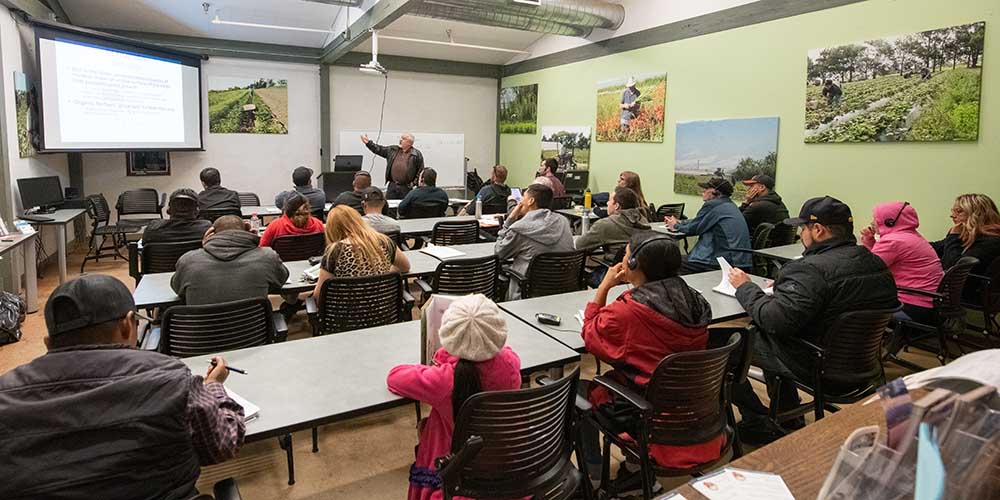
(Photo: USDA)
Preparing the next generation for good-paying jobs that allow them to care for their families and live in the communities where they work is key to creating a truly equitable economy. In the Salinas Valley, investments in agriculture technology and health care career pathways can provide that preparation to the region’s most marginalized communities. This is an important part of Regions Rise Together: Salinas Investment Plan Blueprint’s focus on human capital development.
Hartnell College serves about 11,000 students in the Salinas Valley and has a large population of Dreamers, veterans and students who come from low or very low-income households. It is developing several career pathways, including Agriculture Technology, Nursing and STEM, that could allow their students the opportunity for economic advancement and the ability to stay in their community.
“We have to build more capacity to support those industries that have those types of jobs available for our students and then we have to connect those pathways all the way to employment,” said Jackie Cruz, vice president of Advancement and Development and executive director of the Hartnell College Foundation.
The Agriculture Technology pathway in engineering and mechatronics (engineer technician) will help students upgrade their job skills from the field to management. The “Earn as You Learn” model partners with agriculture technology employers to offer paid internships with a goal of placing 250 students in the next 10 years. Hartnell also plans to develop two new apprenticeship programs with the goal of placing an additional 1,250 students over the same timeframe.
“That’s so powerful because they have seen their parents work in this industry and now they can get to make a whole other type of contribution through the training that they will now have through mechatronics and the different disciplines that are involved in mechatronics,” added Cruz.
The Nursing Pathway aims to increase the enrollment of students of color by 20% and grow the number of transfers to CSU Monterey Bay by 10%, while graduating students with less debt through scholarships and other resources.
“Anything related to health care that has a credential offers the best paying jobs,” explained Cruz. With starting pay at $80,000 or more, she added, “You can change the trajectory of a whole family when students get those opportunities.”
Cruz also discussed the benefit of training healthcare workers locally. “Not only are you looking at it from a racial equity lens that you’re going to give people of color these great jobs, but they’re also going to be able to connect and provide patient care that is culturally sensitive to the patient.”
Much of the work to realize the goals of the Human Capital Development focus of Regions Rise Together: Salinas relies on local leadership development and the support of community-based organizations. Community Organized for Relationship Power in Action (COPA) has developed a “Civic Academy” to develop emerging leaders in the community, identify new potential leaders and expand the constituency around key concerns.
Cruz explained the importance of CBOs to the success of this work. “We could never have had the reach that the CBOs have at the very deepest level in the parts of the community that sometimes are challenging for institutions like ours to really develop.” She added, “Racial equity and community-based partnerships are going to be a symbol and cornerstone of the RRT plan. I hope that approach permeates not just across Hartnell, but with other institutions that are like ours.”
The investment for the Human Capital Development focus area of the Regions Rise Together: Salinas Investment Blueprint is $816 million, which could come from federal, state and philanthropic sources. The Governor’s 2022-23 Budget includes funds that could help achieve the Blueprint goals and includes:
- A $130 million Proposition 98 General Fund one-time increase over three years to support healthcare-focused vocational pathways for English language learners across all levels of English proficiency, through the Adult Education Program.
- A $20 million Proposition 98 General Fund one-time increase for a grant program that incentivizes public-private partnerships that prepare students in grades 9 to 14 for the high-skill fields of education and early education; science, technology, engineering and mathematics (STEM); and healthcare.
- A $25 million Proposition 98 General Fund one-time increase to assist community colleges with the procurement and implementation of software that maps intersegmental curricular pathways to help students choose their pathway, facilitate streamlined transfer between segments, and reduce excess units taken on the path to degree or program completion.
- An $10 million Proposition 98 General Fund ongoing increase to augment resources provided to community college financial aid offices.
This is the fourth in a series on the Regions Rise Together: Salinas Investment Plan Blueprint. The next installment will focus on Economic Opportunity Expansion, which includes how to increase access to well-paying jobs, capital, and wealth pathways.
Part One “A Blueprint For An Equitable Region Rises In California’s Salinas Valley”
Part Two “Accessible Housing And Broadband Make Up A Cornerstone Of California Region’s Equity Plan”
Part Three “Closing The Child Care Gap Is Vital To Monterey County Economic Blueprint”
Part Five “Model For Opening Opportunity, Closing The Wealth Gap Unfolds On The Central Coast“

